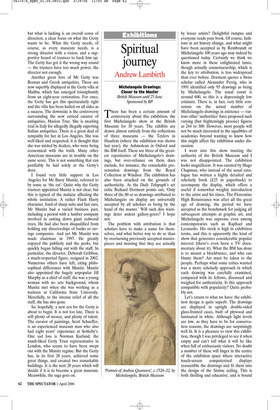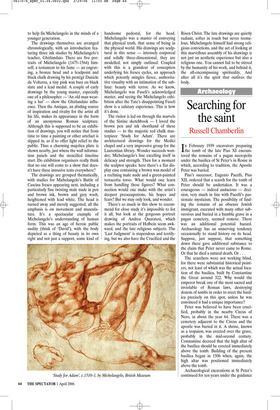Spiritual journey
Andrew Lambirth
Michelangelo Drawings: Closer to the Master British Museum until 25 June Sponsored by BP There has been a certain amount of controversy about this exhibition, the first Michelangelo show at the British Museum for 30 years. The exhibits are drawn almost entirely from the collections of three museums — the Teylers in Haarlem (where the exhibition was shown last year), the Ashmolean in Oxford and the BM itself. These are three of the greatest repositories of Michelangelo’s drawings, but over-reliance on them does exclude, for instance, the remarkable presentation drawings from the Royal Collection at Windsor. The exhibition has also been attacked on the grounds of authenticity. As the Daily Telegraph’s art critic Richard Dorment points out, ‘Only three of the 80 or so drawings attributed to Michelangelo on display are universally accepted by all scholars as being by the hand of the master.’ Will such dire warnings deter ardent gallery-goers? I hope not.
The problem with attribution is that scholars have to make a name for themselves, and what better way to do so than by overturning previously accepted masterpieces and insisting that they are actually by lesser artists? Delightful rumpus and everyone reads your book. Of course, fashions in art history change, and what might have been accepted as by Rembrandt or Michelangelo 100 years ago may indeed be questioned today. Certainly we think we know more in these enlightened times, though actually connoisseurship, which is the key to attribution, is less widespread than ever before. Dorment quotes a Swiss scholar called Alexander Perrig, who in 1991 identified only 95 drawings as being by Michelangelo. The usual count is around 600, so this is a depressingly low estimate. There is, in fact, very little consensus on the actual number of Michelangelo drawings in existence — various other ‘authorities’ have proposed such varying (but frighteningly precise) figures as 244 or 300. However, most people will not be much interested in the squabbles of academics beyond wanting to know how this might affect the exhibition under discussion.
I went into this show trusting the authority of the British Museum and I was not disappointed. The exhibition looks magnificent. It was curated by Hugo Chapman, who instead of the usual catalogue has written a highly detailed and scholarly book (£25 in paperback) to accompany the display, which offers a useful if somewhat weighty introduction to the artist and his times. The Florentine High Renaissance was after all the great age of drawing, the period we have accepted as the benchmark for judging all subsequent attempts at graphic art, and Michelangelo was supreme even among contemporaries such as Raphael and Leonardo. His stock is high in exhibition terms, and this is apparently the kind of show that generates considerable popular interest (there’s even been a TV documentary about it). What the BM has done is to mount a blockbuster, and who can blame them? Art must be taken to the people. Perhaps what some critics wanted was a more scholarly approach in which each drawing was carefully examined, compared with its fellows, discussed and weighed for authenticity. Is this approach compatible with popularity? Quite probably not.
Let’s return to what we have: the exhibition design is quite superb. The drawings are displayed in upright double-sided glass-fronted cases, built of plywood and laminated in white. Although light levels are low, as they have to be for conservation reasons, the drawings are surprisingly well lit. It is a pleasure to view this exhibition, though I was privileged to see it when empty and can’t tell what it will be like when full of enthusiastic visitors. No doubt a number of these will linger in the centre of the exhibition space where interactive touch-screen computerised displays reassemble the drawings and fit them into the design of the Sistine ceiling. This is both thrilling and educative, and is bound to help fix Michelangelo in the minds of a younger generation.
The drawings themselves are arranged chronologically, with an introduction featuring three ink studies by Michelangelo’s teacher, Ghirlandaio. There are five portraits of Michelangelo (1475–1564) himself, a testament to his fame — an engraving, a bronze head and a leadpoint and black chalk drawing by his protégé Daniele da Volterra, a tiny pink wax bust on black slate and a lead medal. A couple of early drawings by the young master, especially one of a philosopher — ‘An old man wearing a hat’ — show the Ghirlandaio influence. Then the Antique, an abiding source of inspiration and rivalry for the artist all his life, makes its appearance in the form of an anonymous Roman sculpture. Although this is supposed to be an exhibition of drawings, you will notice that from time to time a painting or other artefact is slipped in, as if to offer light relief to the public. Thus a charming majolica plate is shown nearby, just where the wall information panels and the stencilled timeline start. Do exhibition organisers really think that no one will come to a show that doesn’t have these intrusive texts everywhere?
The drawings are grouped thematically, with studies for Michelangelo’s Battle of Cascina fresco appearing next, including a particularly fine twisting male nude in pen and brown ink, brown and grey wash, heightened with lead white. The head is turned away and merely suggested, all the emphasis is on movement and musculature. It’s a spectacular example of Michelangelo’s understanding of human form. This was an age of heroic public nudity (think of ‘David’), with the body depicted as a thing of beauty in its own right and not just a support, some kind of handsome pedestal, for the head. Michelangelo was a master of conveying that physical truth, that sense of being in the physical world. His drawings are sculptural in this sense — intensely corporeal and solidly three-dimensional, they are modelled, not simply outlined. Coupled with this is a grandeur of conception underlying his fresco cycles, an approach which potently mingles fierce, authoritative visuality with an intimation of the sublime: beauty with terror. As we know, Michelangelo was Fuseli’s acknowledged master, and seeing the Michelangelo exhibition after the Tate’s disappointing Fuseli show is a salutary experience. This is how it’s done.
The visitor is led on through the marvels of the Sistine sketchbook — I loved the brown pen and ink shorthand of these studies — to the majestic red chalk masterpiece ‘Study for Adam’. There are architectural drawings for the Medici chapel and a very impressive group for the Laurentian library. Wonder succeeds wonder, Michelangelo’s line excelling itself in delicacy and strength. Then for a moment the sculptor speaks: here there’s a flat display case containing a brown wax model of a reclining male nude and a green-painted terracotta torso. What would one learn from handling these figures? What connection would one make with the artist’s deepest preoccupations, his hopes and fears? But we may only look, and wonder.
There’s so much in this show to recommend for close study it’s impossible to list it all, but look at the gorgeous portrait drawing of Andrea Quaratesi, which makes the portraits of Holbein seem awkward, and the late religious subjects. The ‘Last Judgment’ is stupendous and terrifying, but we also have the Crucified and the Risen Christ. The late drawings are quietly radiant, softer in touch but never tremulous. Michelangelo himself had strong religious convictions, and the act of looking at this marvellous assembly of his drawings is not just an aesthetic experience but also a religious one. You cannot fail to be stirred by the humanity of his work, and behind it, the all-encompassing spirituality. And after all it’s the spirit that outlives the body.



























































































 Previous page
Previous page